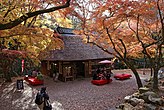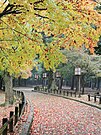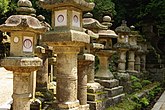Nara Park




Nara Park (奈良公園, Nara Kōen) is a public park located in the city of Nara, Japan, at the foot of Mount Wakakusa. Established in 1880, it is one of the oldest parks in Japan. Administratively, the park is under the control of Nara Prefecture. The park is one of the "Places of Scenic Beauty" designated by the Ministry of Education, Culture, Sports, Science and Technology (MEXT). Over 1,200 wild sika deer (シカ or 鹿 shika) freely roaming around in the park are also under designation of MEXT, classified as natural treasure. While the official size of the park is about 502 hectares (1,240 acres), the area including the grounds of Tōdai-ji, Kōfuku-ji, Kasuga Grand Shrine and Nara National Museum, which are either on the edge or surrounded by Nara Park, is as large as 660 hectares (1,600 acres).
Nara Park began in 1880, when a 14-hectare area within the grounds of Kōfuku-ji, which was government-owned land, was designated as a park. In 1889, Todai-ji, Kasugano and mountainous areas such as Mount Wakakusa were added, expanding the park to 535 hectares. From 1949 to 1951, the park designation within the temple grounds was revoked, reducing the area to 500 hectares. In 1960, it was officially designated as Nara Park under the Urban Park Act, with an area of 502 hectares.[1]
The wild animals that inhabit the park include deer, wild boars, Japanese raccoon dog, Japanese giant flying squirrel, squirrels, and others. The vegetation consists of pine trees, cherry blossom trees, maple trees, plum trees, Japanese cedar and Japanese pieris, among others.[2]
World Heritage Sites, National Treasures and Important Cultural Properties
[edit]The Nara Prefectural Government considers the total area of the Nara Park to be not only the designated area of 502 hectares defined by the Urban Park Act, but also the surrounding Shinto shrines, Buddhist temples, and other areas totaling 660 hectares. Within this 660-hectare area, there are World Heritage Sites, as well as a variety of National Treasures, Important Cultural Properties, and Natural Monuments (Tennen Kinenbutsu) designated by the Japanese government. Todai-ji, Kofuku-ji, Kasuga Grand Shrine, and the Kasugayama Primeval Forest are registered as World Heritage Sites under the title Historic Monuments of Ancient Nara. There are 47 buildings designated as National Treasures and Important Cultural Properties on the grounds of Todai-ji, Kofuku-ji, Kasuga Grand Shrine, Shōsōin, Shin-Yakushi-ji, Gangō-ji, and others. There are 374 arts and crafts designated as National Treasures and Important Cultural Properties, mainly consisting of Buddhist statues and religious arts and crafts found in Buddhist temples and Shinto shrines. The Kasugayama Primeval Forest is designated as a Special Natural Monument (Tokubetsu Tennen Kinenbutsu), while the deer, the habitat of the Panchala ganesa butterfly, the Nageia nagi tree forest of Kasuga Grand Shrine, and the Prunus verecunda 'Antiqua' tree of Chisokuin are designated as Natural Monuments.[2]
Deer
[edit]
According to local folklore, sika deer from this area were considered sacred due to a visit from Takemikazuchi, one of the four gods of Kasuga Grand Shrine.[3] He was said to have been invited from Kashima Shrine in present-day Ibaraki Prefecture,[4] and appeared on Mount Mikasa (also known as Mount Wakakusa) riding a white deer. From that point, the deer were considered divine and sacred by both Kasuga Grand Shrine and Kōfuku-ji.[4] Killing one of these sacred deer was a capital offense up until 1637, the last recorded date of a breach of that law.[4]

After World War II, the deer were officially stripped of their sacred/divine status,[4] and were instead designated as natural monument (天然記念物 Tennen kinenbutsu) and are protected as such. Today, visitors can purchase "deer-crackers" (鹿煎餅 Shika-senbei) to feed the deer in the park. These crackers are exclusively sold by the WNOW company.[3]
In January 2023, a joint research team from Fukushima University, Yamagata University, and Nara University of Education revealed that among sika deer inhabiting the Kii Peninsula, those in Nara Park form a unique genetic population.[5][6] The results of the large-scale genetic research showed that while 18 mitochondrial DNA genotypes were detected in deer living on the Kii Peninsula, only one of these genotypes was detected in deer living in Nara Park, which is not found in deer living in other areas of the Kii Peninsula. The genetic differentiation of the Nara Park deer from the Kii Peninsula deer population occurred about 1,400 years ago, which is genetically close to the year 768, when the Kasuga Grand Shrine was built. The results of this research confirm that the Japanese people have been protecting the deer in this area for more than 1,000 years as messengers of Takemikazuchi, the main deity of Kasuga Grand Shrine, and that this has allowed the deer in this area to maintain their population from generation to generation.[7][8]
Problems related to deer
[edit]The number of deer grew in the postwar period to around 1,200 in 2008, leading to concerns about environmental and crop damage and discussion of culling.[9] In 2016, a record number of 121 people were injured by deer.[10] In 2016 it was announced that the area around Nara would be designated into four different zones, with the outer zones allowing deer to be captured and killed.[11] In August 2017, traps were set to catch deer on the outskirts of Nara.[12][13] The culling started in 2017, with a limit of 120 deer to be culled during 2017.[14] In July 2017 there were around 1,500 deer living in the park, and at least 164 people had been injured by them from 2017 to 2018. Most of them were tourists feeding the deer.[15] In April 2018 Nara city set up new signs in English, Chinese and Japanese informing tourists that the deer are wild animals and to not tease them during feeding.[16][17]
A 2009 study by Harumi Torii (who is an assistant professor of wildlife management at Nara University of Education), who conducted necropsies on deceased shika deer in Nara Park, found that the deer in Nara Park were malnourished.[18] According to forest journalist Atsuo Tanaka, while the average male deer weighs about 50 kg, the deer in Nara Park weighs only about 30 kg and is small and thin, and the color of the marrow in its femur indicates that it is malnourished. The number of deer in Nara Park is much higher than the 780 deer that can live in the park, which is derived from the area of the park's lawn. The deer supplement their diet with crackers given to them by tourists, but these crackers are made of wheat flour and rice bran and are unbalanced in nutritional content. While the deer in the park are chronically malnourished, the average life expectancy is 20 years, much longer than in the wild, because humans care for injured, sick, and pregnant deer.[19] Meanwhile, according to the Nara Deer Preservation Foundation, the average weight of a five-year-old male deer as of 2018 was 74 kg, even though deer in Nara Park are genetically smaller than deer elsewhere.[20]
Due to the COVID-19 pandemic in 2020, the Japanese government implemented travel restrictions. The amount of tourists feeding the Nara deer decreased significantly. The deer lost a vital source of food and began to forage outside of the park. There were concerns that the deer could get hit by vehicles or die from eating harmful plastic and other litter.[21] Some of the deer were observed to be emaciated and not eating the grass in front of them, probably because they had become dependent on crackers, while some deer were observed to have started eating grass, which improved their intestinal environment and the condition of their feces.[22]
In 2010, a man and woman were arrested and jailed for shooting a deer with a crossbow. In 2021, a man was arrested for fatally injuring a deer with an axe.[23][24]
In popular culture
[edit]Alt-J's 2014 album, This Is All Yours has the track "Nara" which mentions Nara Park in its lyrics.[25]
My Deer Friend Nokotan predominantly features deer crackers as well as Nara Park. The closing of the anime based on the manga shows production of deer crackers alongside footage of deer at Nara Park.[26]
Transport
[edit]Nara Park is serviced by the Kintetsu Nara Station and it is reachable by the Kintetsu Line from Osaka-Namba Station.
Gallery
[edit]-
Ukimidou Pavilion
-
Chaya opens
-
Torii of Kasuga Grand Shrine inside the park
-
A path inside the park
-
More than 1000 Kasuga Grand Shrine lanterns adorn the park
-
Deer approaching tourists
-
The deer are freely roaming around in both park and temples
-
Nara Park, photograph by Adolfo Farsari (before 1898).
References
[edit]- ^ 奈良公園基本戦略 参考資料2 (PDF) (in Japanese). Nara Prefecture. pp. 42, 43. Archived from the original (PDF) on 22 June 2022. Retrieved 13 June 2023.
- ^ a b 奈良公園基本戦略 参考資料1 (PDF) (in Japanese). Nara Prefecture. p. 2‐6. Archived from the original (PDF) on 26 March 2023. Retrieved 13 June 2023.
- ^ a b Fodor's Japan 18th Edition (2007)
- ^ a b c d Noburu Ogata. "Soramitsu, history and geography of Nara, Japan".
- ^ Takagi, Toshihito; Murakami, Ryoko; Takano, Ayako; Torii, Harumi; Kaneko, Shingo; Tamate, Hidetoshi B (30 January 2023). "A historic religious sanctuary may have preserved ancestral genetics of Japanese sika deer (Cervus nippon)". Journal of Mammalogy. doi:10.1093/jmammal/gyac120. PMC 10075338. Retrieved 7 February 2023.
- ^ [Press Release] Protecting Messengers of the Gods: Conservation of Nara Park Deer has Resulted in Unique Genetic Lineage 福島大学. Fukushima University. 15 March 2023. Retrieved 16 March 2023.
- ^ 奈良のシカ、独自の遺伝子型保つ 人の保護で千年以上維持か (in Japanese). Livedoor News. 31 January 2023. Archived from the original on 31 January 2023. Retrieved 31 January 2023.
- ^ 奈良公園の鹿に独自の特徴 千年超の歴史、DNAと資料でしかと確認 (in Japanese). Asahi Shimbun. 31 January 2023. Archived from the original on 31 January 2023. Retrieved 31 January 2023.
- ^ Bird, Winfred (October 29, 2008). "Nara's cute, destructive deer". Japan Times. Retrieved June 2, 2018.
- ^ "More foreign tourists injured by deer at Nara Park". Mainichi Shimbun. May 6, 2017. Retrieved June 2, 2018.
- ^ Otake, Tomoko (March 3, 2016). "Nara to allow some deer to be culled under new management policy". Japan Times. Retrieved June 2, 2018.
- ^ Sugawara, Yuta (July 31, 2017). "Nara's sacred deer reined in as species is blamed for crop damage". Asahi Shimbun. Retrieved June 5, 2018.
- ^ Fifield, Anna (August 1, 2017). "Japan's famous Nara deer are being culled". Washington Post. Retrieved June 2, 2018.
- ^ Baseel, Casey (August 8, 2017). "Nara begins deer culling program". Japan Today. Retrieved June 2, 2018.
- ^ Aoki, Mizuho (February 8, 2018). "Nara announces record number of deer bites as tourists flood in". Japan Times. Retrieved June 3, 2018.
- ^ "Oh deer! Nara urges use of 'deer sign language' by tourists after more get bitten by hungry animals". Japan Times. April 3, 2018. Retrieved June 5, 2018.
- ^ "New signs installed in Nara on how to feed deer". Japan Times. April 9, 2018. Retrieved June 5, 2018.
- ^ Nutritional condition assessment by color of femur marrows of sika deer in Nara Park, Nara prefecture
- ^ Tanaka, Atsuo (4 July 2018). "奈良の鹿は栄養失調? 鹿せんべい食えたらイイわけじゃない". Yahoo Japan News. Archived from the original on 6 June 2023. Retrieved 13 June 2023.
- ^ Okada, Naoko (7 March 2019). "「奈良のシカ 小型化」ホント?(もっと関西)". The Nikkei. Archived from the original on 26 December 2022. Retrieved 13 June 2023.
- ^ Roth, Annie (2020-03-16). "Brawling Monkeys. Wandering Deer. Blame Coronavirus". The New York Times. ISSN 0362-4331. Retrieved 2020-09-26.
- ^ Kuwajima, Hiroto (1 October 2020). "Nara's Deer Miss the Tourists: Some Relearn Natural Diet While Others Grow Thin". Japan Forward. Archived from the original on 25 September 2022. Retrieved 13 June 2023.
- ^ "Nara Park deer shot in belly with crossbow". Japan Times. March 15, 2010. Retrieved June 5, 2018.
- ^ "Deer killed by man with axe in Nara". SoraNews24 -Japan News-. 2021-03-03. Retrieved 2021-09-26.
- ^ Bell, Corey. "Alt-J Album Preview – This Is All Yours". Best New Bands. Retrieved 22 September 2014.
- ^ Valdez, Nick. "My Deer Friend Nokotan Opening, Ending Released: Watch". Comicbook. Retrieved 14 August 2024.










